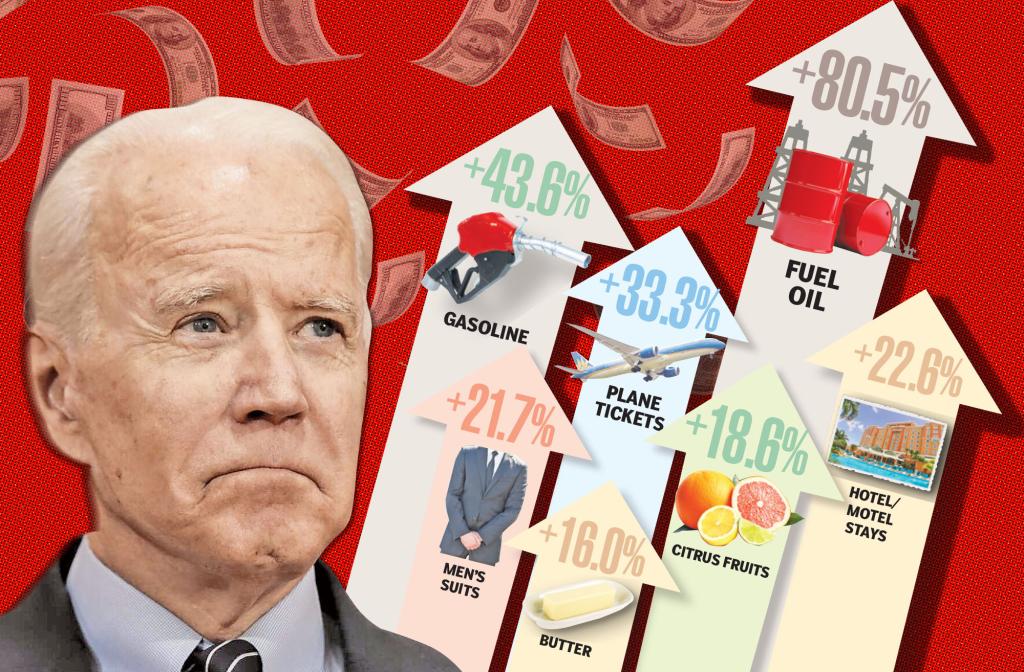Washington’s latest inflation report shows prices rising by 8.3% over the past year and core inflation (which excludes volatile food and energy prices) continuing to accelerate. Real wages have failed 2.7%. Moody’s Analytics and Penn-Wharton estimate that inflation is costing the average household $300 per month. A Harris poll reveals that 84% of Americans are cutting back on key purchases. And the problem is deepening every month.
The Federal Reserve must lead the charge of reducing inflation. After dumping $4.8 trillion into the economy during the recession and continuing to buy mortgage-backed securities as recently as two months ago, the Fed is finally taking inflation seriously by raising rates and reducing its balance sheet. This will be painful but necessary.
Yet much more can be done. President Biden continues to insist that he is working tirelessly to reduce inflation, but his administration has worsened the problem and refused to make the difficult choices that may anger its allied interest groups.
There is a blueprint, however, for the president and Congress to help reduce inflation.
First, stop the spending spree. A major inflation driver was last year’s $1.9 trillion American Rescue Plan. At the time, the Congressional Budget Office estimated that the baseline economy would operate $420 billion below capacity in 2021 and then gradually close that output gap by 2025. While some stimulus was justified, lawmakers shot a $1.9 trillion bazooka at a $420 billion output gap. And this was just weeks after the December 2020 stimulus law poured into $900 billion. Economists on the left and right, such as Lawrence Summers, warned this excessive stimulus would bring inflation. They were right.


Despite that momentous policy error, Biden continues to support a Build Back Better extravaganza that would cost trillions of dollars. And he inexplicably claims all this federal spending would decrease inflation. Congress should be reining in excess stimulus and spending, not adding more.
Second, reverse other inflation-causing policies. The Biden administration has hiked tariffs on Canadian lumber and added tariffs on other building materials. It renewed President Donald Trump’s tariffs on solar panels, extended the tariffs on Chinese imports and imposed tariff quotas on steel. It imposed Buy American provisions raising the cost of infrastructure and is working to expand Davis-Bacon policies that raise the cost of government contracts.
The White House is defending the Jones Act, which raises shipping costs, and allows a higher ethanol blend in gasoline that will increase food prices. It has also deferred student loan payments well past the point justified by the unemployment rate. Lastly, the White House imposed expensive new environmental regulations that will significantly delay and raise the cost of infrastructure, undermining last year’s $550 billion infrastructure law.

Biden also has severely constrained oil, coal and natural gas exploration with a series of moratoriums, permitting regulations and economic reforms to discourage investment in fossil-fuel companies. Unless reversed, this will contribute to long-term energy inflation, especially as we import less from Russia.
Advocates defend these policies as achieving other important goals. But cumulatively, they significantly worsen an inflation problem that is already sinking under the weight of fiscal policy, monetary policy, supply chain disruptions and the war in Ukraine. The Peterson Institute for International Economics calculates that even a 2 percentage-point reduction in tariffs could lower inflation by 1.3% and save $800 per household a year.
Finally, clear up the shipping backlog at our ports. This requires addressing the local unions that have long limited the number of workers and hours and fought productivity-enhancing automation and technology (such as automated cranes) out of fear it would cost union jobs.

Inflation is a global phenomenon driven primarily by the aggressive central-bank responses to the pandemic and recession. But the first rule for elected officials should be to do no harm. That means restraining federal spending, encouraging energy exploration and ensuring that businesses can operate efficiently without expensive tariffs and over-regulation.
The president and Congress have inflation-fighting tools at their disposal. The question is whether they will use them.
Brian Riedl is a senior fellow at the Manhattan Institute. Twitter: @Brian_Riedl
.
